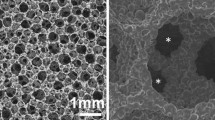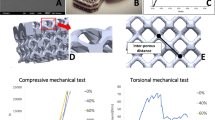Abstract
This investigation was undertaken to simulate in an animal model the particles released from a porous nitinol interbody fusion device and to evaluate its consequences on the dura mater, spinal cord and nerve roots, lymph nodes (abdominal para-aortic), and organs (kidneys, spleen, pancreas, liver, and lungs). Our objective was to evaluate the compatibility of the nitinol particles with the dura mater in comparison with titanium alloy. In spite of the great use of metallic devices in spine surgery, the proximity of the spinal cord to the devices raised concerns about the effect of the metal debris that might be released onto the neural tissue. Forty-five New Zealand white female rabbits were divided into three groups: nitinol (treated: N = 4 per implantation period), titanium (treated: N = 4 per implantation period), and sham rabbits (control: N = 1 per observation period). The nitinol and titanium alloy particles were implanted in the spinal canal on the dura mater at the lumbar level L2–L3. The rabbits were sacrificed at 1, 4, 12, 26, and 52 weeks. Histologic sections from the regional lymph nodes, organs, from remote and implantation sites, were analyzed for any abnormalities and inflammation. Regardless of the implantation time, both nitinol and titanium particles remained at the implantation site and clung to the spinal cord lining soft tissue of the dura mater. The inflammation was limited to the epidural space around the particles and then reduced from acute to mild chronic during the follow-up. The dura mater, sub-dural space, nerve roots, and the spinal cord were free of reaction. No particles or abnormalities were found either in the lymph nodes or in the organs. In contact with the dura, the nitinol elicits an inflammatory response similar to that of titanium. The tolerance of nitinol by a sensitive tissue such as the dura mater during the span of 1 year of implantation demonstrated the safety of nitinol and its potential use as an intervertebral fusion device.





Similar content being viewed by others
References
Armitage DA, Grant DM, Parker TL et al (1997) Haemocompatibility of surface modified NiTi. In: Pelton A, Hodgson D, Russell S, Duerig T (eds) Proceedings of the 2nd international conference on shape memory and superelastic technologies, SMST, Monterey, CA, pp 401–406
Assad M, Chernyshov AV, Leroux MA et al (2002) A new porous titanium-nickel alloy: part 1. Cytotoxicity and genotoxicity evaluation. Biomed Mater Eng 12:225–237
Assad M, Chernyshov AV, Leroux MA et al (2002) A new porous titanium-nickel alloy: part 2. Sensitization, irritation and acute systemic toxicity evaluation. Biomed Mater Eng 12:339–346
Assad M, Jarzem P, Leroux MA, Coillard C, Chernyshov AV, Charette S, Rivard CH (2003) Porous nitinol for lumbar intervertebral fusion in a sheep model: part 1. Histomorphometric and radiological analysis. J Biomed Mater Res 64B(2):107–120
Assad M, Jarzem P, Leroux MA, et al (2003) Porous nitinol for lumbar intervertebral fusion in a sheep model: part 2. Surface analysis and nickel release assessment. J Biomed Mater Res 64B(2):121–129
Assad M, Lemieux N, Rivard CH et al (1999) Comparative in vitro biocompatibility of nickel-titanium, pure nickel, pure titanium, and stainless steel: genotoxicity and atomic absorption evaluation. Biomed Mater Eng 9:1–12
Assad M, Yahia LH, Rivard CH, Lemieux N (1998) In vitro biocompatibility assessment of a nickel-titanium alloy using electron microscopy in situ end-labeling (EM-ISEL). J Biomed Mater Res 41:154–161
ASTM E8-01 (2002) Standard test methods for tension testing of metallic materials. Volume 03.01
ASTM F2077-01 (2001) Test methods for intervertebral body fusion devices
Banwart JC, Asher MA, Hassanein RS (1995) Iliac crest bone graft harvest donor site morbidity. A statistical evaluation. Spine 20:1055–1060
Berger-Gorbet M, Broxup B, Rivard CH (1996) Biocompatibility testing of NiTi screws using immunohistochemistry on sections containing metallic implants. J Biomed Mater Res 32:243–248
Brantigan JW, McAfee PC, Cunningham BW, Wang H, Orbegoso CM (1994) Interbody lumbar fusion using a carbon fiber cage implant versus allograft bone. An investigational study in the spanish goat. Spine 19:1436–1444
Brantigan JW, Steffee AD, Lewis ML et al (2000) Lumbar interbody fusion using the Brantigan I/F cage for posterior lumbar interbody fusion and the variable pedicle screw placement system: two-year results from a food and drug administration investigational device exemption clinical trial. Spine 25:1437–1446
Brayda-Bruno M, Fini M, Pierini G, Giavaresi G, Rocca M, Giardino R (2001) Evaluation of systemic metal after spinal pedicular fixation with titanium alloy and stainless steel system: a 36-month experimental study in sheep. Int J Artif Organs 24(1):41–49
Brodke DS, Dick JC, Kunz DN et al (1997) Posterior lumbar interbody fusion. A biomechanical comparison, including a new threaded cage. Spine 22:26–31
Brodke DS, Willie BM, Maarane EA et al (2002) Spinal cage retrieval assessment of biological response. J Spinal Disord Tech 15:206–212
Canadian Council on Animal Care (CCAC) (1980–1984) Guide to the care and use of experimental animals, two volumes. Ottawa, ON, Canada
Cunningham BW, Orbegoso CM, Dimitriev AE et al (2002) The effect of spinal particulate wear debris: an in vivo rabbit model and applied clinical study of retrieved instrumentation cases. Spine J 27:1971–1981
Goulet JA, Senunas LE, De Silva GL et al (1997) Autogenous iliac crest bone graft. Complications and functional assessment. Clin Orthop 339:76–81
International Organization for Standardization (ISO) (1992) Biological evaluation of medical devices—#10993-6: tests for local effects after implantation, ISO, Geneva, Switzerland, pp 1–9
International Organization for Standardization (ISO) (1992) Biological evaluation of medical devices—#10993-2: animal welfare requirements, ISO, Geneva, Switzerland, pp 1–9
Itin VI, Gunther VE, Shabalovskaya SA et al (1994) Mechanical properties and shape memory of porous nitinol. Mater Characterization 32:179–187
Kurz LT, Garfin SR, Booth RE Jr (1989) Harvesting autogenous iliac bone grafts. A review of complications and techniques. Spine 14:1324–1331
Kuslich SD, Ahern JW, Dowdle JD (1996) The BAK method of lumbar interbody fusion—two year follow up results. In: Proceedings of the 11th annual meeting of the North American spine society, Vancouver, BC, Canada, p 123
Kuslich SD, Dowdle JD (1994) Two-year follow up results of the BAK interbody fusion device. In: Proceedings of the 9th annual meeting of the North American spine society, Minneapolis, Minnesota, USA, p 28
Kuslich SD, Ulstrom CL, Griffith SL et al (1998) The bagby and kuslich method of lumbar interbody fusion. History, techniques, and 2-year follow-up results of a United States prospective, multicenter trial. Spine 23:1267–1279
Merrit K, Brown SA (1993) Particulates metals. In: Morrey BF (ed) Experimental studies. Biological, material, and mechanical consideration of joint replacement, Chapter 12. Raven Press, New York, pp 147–159
Mody DR, Esses SI, Heggeness H (1994) A histologic study soft tissue reactions to the spinal implnats. Spine 19:1153–1156
Regan JJ, Yuan H, McAfee PC (1999) Laparoscopic fusion of the lumbar spine: minimally invasive spine surgery. A prospective multicenter study evaluating open and laparoscopic lumbar fusion. Spine 24:402–411
Rhalmi S, Odin M, Assad M et al (1999) Hard, soft tissue and in vitro cell response to porous nickel-titanium: a biocompatibility evaluation. Biomed Mater Eng 9(3):151–162
Rhalmi S, Assad M, Leroux M et al (2003) Spinal evaluation of porous nitinol particles: a short-term study in rabbits. In: Proceedings of the 49th annual meeting of orthopedic research society, New Orleans, LA, USA, 2–5 February
Rhalmi S, Charette S, Assad M et al (2003) Spinal cord reaction to nitinol and titanium particles: a 1-year study in rabbits. In: Proceedings of the North America Spine Society (NASS), 18th annual meeting, San Diego, CA, USA, 21–25 October
Rivard CH, Rhalmi S, Coillard C (2002) In vivo biocompatibility testing of PEEK polymer for a spinal implant system: a study in rabbits. J Biomed Mater Res 62(4):488–498
Rivard CH, Rhalmi S (1998–1999) Metal ion concentration in sheep with spinal implants: a long-term study. Orthopaedic Transactions. J Bone Joint Surg Can Res Soc 22(2):486
Ryhanen J, Kallioinen M, Tuukkanen J et al (1998) In vivo biocompatibility evaluation of nickel-titanium shape memory metal alloy: muscle and perineural tissue responses and encapsule membrane thickness. J Biomed Mater Res 41:481–488
Ryhanen J, Niemei E, Serlo W et al (1997) Biocompatibility of nickel-titanium shape memory metal and its corrosion behavior in human cell cultures. J Biomed Mater Res 35:451–457
Schrooten J, Assad M, Leroux MA et al (2004) In vitro evaluation of porous nitinol corrosion resistance. In: Proceedings of the 7th world biomaterials congress, Sydney, Australia, 17–21 May
Sawin PD, Traynelis VC, Menezes AH (1998) A comparative analysis of fusion rates and donor-site morbidity for autogenic rib and iliac crest bone grafts in posterior cervical fusions. J Neurosurg 88(2):255–265
Shabalovskaya SA (1996) On the nature of the biocompatibility and on medical applications of Ni-Ti shape memory and superelastic alloys. Biomed Mater Eng 6(4):267–289
Standard Practice for Assessment of Compatibility of Biomaterials for Surgical Implants with Respect to Effect of Materials on Muscle and Bone. ASTM F981-99 (2002) Annual book of ASTM standards, Section 13, Medical devices and services, ASTM International, West Conshohocken, PA
Standard Practice for Short-Term Screening of Implant Materials. ASTM F763-99 (2002) Annual book of ASTM standards, Section 13, Medical devices and services, ASTM International, West Conshohocken, PA
Summers BN, Eisenstein SM (1989) Donor site pain from ilium. A complication of lumbar spine fusion. J Bone Joint Surg Br 71(4):677–680
Thébault MA, Moreau, Assad M et al (2004) Mechanical testing of porous nitinol for intrevertebral fusion devices. In: Proceedings of the 50th annual meeting of orthopedic research society, San Francisco, CA, USA, 7–10 March
Thébault MA, Moreau, Assad M et al (2004) Cervical interboby fusion devices: a load-induced subsidence resistance evaluation. In: Proceedings of the 7th world biomaterials congress, Sydney, Australia, 17–21 May
Togawa D, Bauer TW, Lieberman IH et al (2003) Histology of tissues within retrieved human titanium mesh cages. Spine 28:246–254
Turner JE, Lawrence WH, Autian J (1973) Subacute toxicity testing of biomaterials using histopathologic evaluation of rabbit muscle tissue. J Biomed Mater Res 7(1):39–58
Wang JC, Yu WD, Sandhu HS et al (1999) Metal debris from titanium implants. Spine 24:899–903
Wever DJ, Veldhuizen AG, Sanders MM (1997) Cytotoxic and genotoxic activity of a nickel-titanium alloy. Biomaterials 18(16):1115–1120
Author information
Authors and Affiliations
Corresponding author
Rights and permissions
About this article
Cite this article
Rhalmi, S., Charette, S., Assad, M. et al. The spinal cord dura mater reaction to nitinol and titanium alloy particles: a 1-year study in rabbits. Eur Spine J 16, 1063–1072 (2007). https://doi.org/10.1007/s00586-007-0329-7
Received:
Revised:
Accepted:
Published:
Issue Date:
DOI: https://doi.org/10.1007/s00586-007-0329-7




